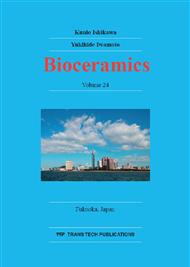p.129
p.133
p.138
p.143
p.147
p.153
p.157
p.161
p.167
Evaluating Initial Content of the Slurry and Cooling Rate on the Microstructural and Mechanical Characteristics of Freeze Casted Hydroxyapatite Macroporous Scaffolds
Abstract:
Scaffolds have to meet exacting physical, chemical, and biological criteria to function successfully, and those criteria vary with the type of tissue being repaired. In the present work, slurry with different initial content of 7.5-22.5 vol% HA prepared from calcinated hydroxyapatite. The prepared slurries freeze casted unidirectionally with the different cooling rate of 2-14°C/min with intervals of 3°C/min from the ambient temperature. Then, green bodies freeze-dried for 72h following with sintering at temperatures of 1350°C. The results showed that compressive strength goes up with cooling rate and initial content. Total porosity has a range of 66-88% while has a compressive strength of ~0.4-18 MPa. Porosity size has a value of 20-200 μm by initial content and cooling rate. Based on strength and porosity, the specimen with initial content and cooling rate of 15 vol% and 5°C/min, respectively, chose to be the optimum. This specimen has a compressive strength and porosity size of 5.26 MPa and 88 μm, respectively. The compressive strength value of the mentioned lamellar HA scaffolds was in the range of the values reported for human proximal tibia.
Info:
Periodical:
Pages:
147-152
Citation:
Online since:
November 2012
Price:
Сopyright:
© 2013 Trans Tech Publications Ltd. All Rights Reserved
Share:
Citation:


